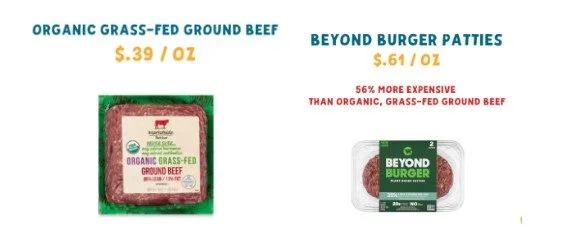Diana Rodgers: January 2023 Update
Taking a Fresh Look at the Value of Meat
A few of the recent conferences I’ve attended featured market research into why people are reducing their meat consumption. You might guess that it has to do with the ongoing anti-meat narrative that meat is bad for the environment, but to my surprise, that was not one of the top reasons.
It turns out that price and health are the two top reasons why consumers have been opting for chicken or more plant-based proteins and cutting down on red meat spending. And the good news is that we have a great opportunity to change their minds.
I’ve talked before about the nutritional value of meat, and how it just cannot compare to plant-based alternatives. There’s also great research about how the vitamins and minerals in meat are the best way to fight the top nutrient deficiencies worldwide, like iron, vitamin B12, vitamin A and zinc.
But we also have a fantastic story when it comes to price. I went to Walmart.com (an accessible grocery store to people in the US) and looked up the price per pound of organic, grass-fed ground beef. I then compared it to several common items that are either considered “healthy” but have less nutrients than beef, are considered “common” and are less nutritious than beef… And they were all more expensive per pound than the “high end” beef.
Here are some examples:
The Beyond Burger meat alternative is more expensive than the organic grass-fed ground beef and less nutritious. While it does provide a substantial amount of protein, the plant-based protein sources are less bioavailable than from real beef, and the micronutrients profile comes from fortified synthetic nutrients, which like protein, are not as bioavailable as eating the vitamin or mineral in its real food form.
Similarly, when we compare plant-based tofurky “deli meat” to the organic grass-fed ground beef, we see that the real meat is not only cheaper, but more nutritious, which is clear when you compare the one ingredient beef to the long list of ingredients in the deli slices.
If I were to post a picture of a salad with spring mix or a bowl of raspberries, I don’t think anyone would say I'm promoting elitist foods. When in fact, organic spring mix from Walmart is considerably more expensive per ounce than the organic grass-fed beef. Not to mention, the difference in nutritional value between these two foods. Vegetables have an important role in a healthy, balanced diet, but there’s no question that beef is a more nutrient-dense option, especially when it comes to providing the nutrients that are of most concern for nutrient deficiencies like iron, zinc, essential fatty acids, and vitamins A and B12.
Organic “Spring Mix” Salad Greens = $0.60 per ounce, 54% more expensive than meat
Organic Raspberries = $0.59 per ounce, 51% more expensive than meat
Next, I compared the organic grass-fed ground beef to a cliff bar, which is widely accepted as a ‘healthy snack bar”. At 46 cents per ounce, a cliff bar is significantly more expensive than the organic, grass-fed ground beef. And when you look at the ingredient list and account for the nutritional value of each of these, the beef is the clear winner.
You can read and share the full post here and see the comparisons with granola, cheerios, candy, and junk food snacks. I also compared red meat to other proteins, broke out the protein per serving and the cost per ounce in a bar graph.
In conclusion, when looking at meat, we should be shifting the conversation to nutrients per serving and consider the value per dollar spent in this way, which clearly makes meat the winner.
Diana Rodgers, RD



